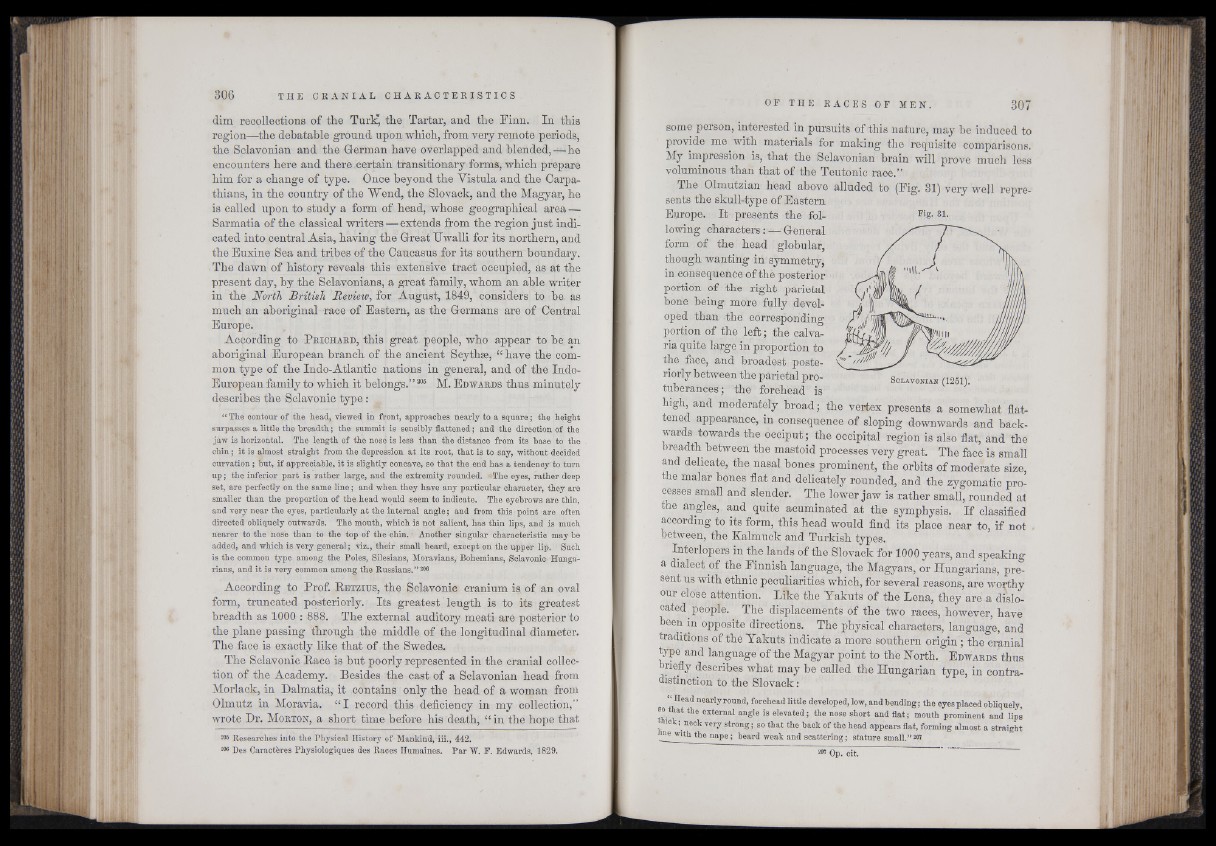
dim recollections of tlie Turk* tlie Tartar, and the Finn. In this
region—the debatable ground upon which, from very remote periods,
the Sclavonian and the German have overlapped and blended,—he
encounters here and there certain transitionary forms, which prepare
him for a change of type. Once beyond the Vistula and the Carpathians,
in the country of the Wend, the Slovack, and the Magyar, he
is called upon to study a form of head, whose geographical area —
Sarmatia of the classical writers — extends from the region just indicated
into central Asia, having the Great TJwalli for its northern, and
the Euxine Sea and tribes of the Caucasus for its southern boundary.
The dawn of history reveals- this extensive tract occupied, as at the
present day, by the Sclavonians, a great family, whom an able writer
in the North British Review, for August, 1849, considers to he as
much an aboriginal race of Eastern, as the Germans are of Central
Europe.
According to P richard, this great people, who appear to he an
aboriginal European branch of the ancient Scythse, “ have the common
type of the Indo-Atlantie nations in general, and of the Indo-
European family to which it belongs.”205 M. E dwards thus minutely
describes the Sclavonic type: ,
“ The contour of the head, viewed in front, approaches nearly to a square; the height
surpasses a little the breadth; the summit is sensibly flattened; and the direction of the
jaw is horizontal. The length of the nose is less than the distance from its base to the
chin; it is almost straight from the depression at its root, that is to say, without decided
curvation ; but, if appreciable, it is slightly concave, so that the end has a tendency to turn
up; the inferior part is rather large, and the extremity rounded. »The eyes, rather deep
set, are perfectly on the same line; and when they have any particular character, they are
smaller than the proportion of the. head would seem to indicate. The eyebrows are thin,
and very near the eyes, particularly at the internal angle; and from this • point are often
directed obliquely outwards. The mouth, which is not salient, has thin lips, and is much
nearer to the nose than to the top of the chin. Another singular characteristic may be
added, and which is very general; viz., their small beard, except on the upper lip. Such
is the common type among the Poles, Silesians, Moravians, Bohemians, Sclavonic' Hungarians,
and it is very common among the Russians.” 206
According to Prof. R etzius, the Sclavonic cranium is of an oval
form, truncated posteriorly. Its greatest length is to its greatest
breadth as 1000 : 888. The external auditory meati are posterior to
the plane passing through the middle of the longitudinal diameter.
The face is exactly like that of the Swedes.
The Sclavonic Race is hut poorly represented in the cranial collection
of the Academy. Besides the cast of a Sclavonian head from
Morlack, in Dalmatia, it contains only the head of a woman from
Olmutz in Moravia. “ I record this deficiency in my collection,”
wrote Dr. M orton, a short time before his death, “ in the hope that
205 Researches into the Physical History of Mankind, iii., 442.
206 Des Caractères Physiologiques des Races Humaines. Par W. F. Edwards, 1829.
some person, interested in pursuits of this nature, may he induced to
provide me with materials for making the requisite comparisons.
My impression is, that the Sclavonian brain will prove much less
voluminous than that of the Teutonic race.”
: The Olmutzian head above alluded to (Fig. 31) very well represents
the skull-type of Eastern
Europe. It presents the fol- Fis- 81-
lowing characters : — General
form of the head globular,
though wanting in symmetry,
in consequence of thè posterior
portion of the right parietal
bone being more fully developed
than the corresponding
portion of the left; the calva-
ria quite large in proportion to
the face, and broadest posteriorly
between the parietal pro- S c la v o n ia n (1 2 5 1 ) .
tuherances ; the forehead is
high, and moderately broad ; the vertex presents a somewhat flattened
appearance, in consequence of sloping downwards and backwards
towards the occiput ; the occipital region is also flat, and the
breadth between the mastoid processes very great. The face is small
and delicate, the nasal bones prominent, the orbits of moderate size,
the malar bones flat and delicately rounded, and the zygomatic processes
small and slender. The lower jaw is rather small, rounded at
the angles, and quite acuminated at the symphysis. If classified
according to its form, this head would find its place near to, if not
between, tbe Kalmuck and Turkish types.
Interlopers in the lands òf the Slovack for 1000 years, and speaking
a dialect of the Finnish language, the Magyars, or Hungarians, present
us with ethnic peculiarities which, for several reasons, are worthy
our close attention. Like the Yakuts of the Lena, they are a dislocated^
people. The displacements of the two races, however, have
been in opposite directions. The physical characters, language, and
traditions of the Yakuts indicate a more southern origin ; the cranial
type and language of the Magyar point to the Yorth. Edwards' thus
briefly describes what may he called the Hungarian type, in contra-
distinction to the Slovack :
“ Head nearly round, forehead little developed, low, and bending ; the eyes placed obliquely,
so that the external angle is elevated; the nose short and flat; mouth prominent and lips
ick ; neck very strong ; so that the back of the head appears flat, forming almost a straight
ine with the nape ; beard weak and scattering ; stature small.” 207
207 Op. cit.